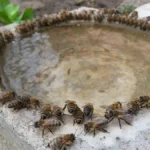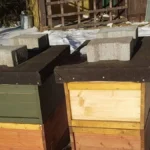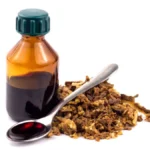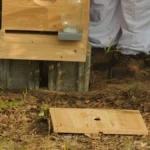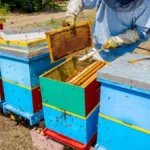Moisture control in beehives is crucial to prevent fungus and disease problems. One simple method you can use is a so-called “Quilt box for bees”. A quilt box for bees provides both ventilation, insulation, and moisture control and can be made out of simple things you can scrounge for. In my experience, the boxes are also an excellent way of collecting a bit of propolis. More on that shortly. Let’s first explain what a quilt box for bees is.
If we look at how a beehive works, we have a large number of insects packed into a small space. The small space is further complicated by it being full of combs. Some of these combs contain brood that releases carbon dioxide and moisture. Some of these combs contain pollen and nectar which release moisture and are also an excellent food source for microbes.
Heat rises, and generally, the brood nest is the warmest part of the hive. In an area where you have warm days and cool nights, or when it is actually just cold weather, the warm moisture-rich air rises out of the brood nest and can condense on the lid. The condensation drips back down into the hive and causes fungal problems.
Candy Boards For Moisture Control and Feeding
We have had a look at candy boards that control moisture AND feed bees during cold winters. However, in an area like mine, spring build-up periods are often characterized by warm days and cool nights. There are strong spring honey flows, and the moisture gathers in the hives causing general ill health for the bees.
Quilt Boxes For Moisture Control and Insulation
There is no logic in feeding bees during a honey flow, hence I need an alternative moisture control system that provides insulation at the same time. In this regard, I have used quilt boxes for bees. Somewhat ironically it is only now that I am writing this article that I am learning the proper name for it. We called them sawdust boxes.
Some people call them beehive quilt boxes or bee moisture quilt. Basically, these are all the same thing, and should not be confused with a “beekeepers quilt” which is a type of blanket thing that you can make with fluffy fabric and thread. The beekeepers’ quilt is for insulating you – all the other terms are for the thing we will talk about in the rest of this article and refer to as a quilt box for bees.
What Is A Quilt Box For Bees?
This is really a very simple thing to make. Take an old shallow super and stable a bit of shade cloth to the bottom of the super. I note a lot of Youtube guides use hessian sack – my bees just eat hessian so I use shade cloth. Shade cloth is great because it is strong, and you can pull it off the box when it gets propolized, place it in the freezer, and then roll it to harvest the propolis. More on that later (by propolized I refer to the way some bees will glue everything with bee glue or propolis).
I normally put a few small pieces of wood across the box and staple the shade cloth to this as well for some additional strength and support. Once you have made this, you place two inches of sawdust shavings (make sure it is not sawdust that has any poisons in it) on top of the shade cloth. You then place the lid on top of this super box.
How Does A Beehive Quilt Box Work?
The mode of operation of this system is really simple. You remove the lid of the hive. Place the quilt box on top of the frames, and put the lid on the quilt box. Done. The moisture rises through the sawdust and the heat stays behind. This causes the moisture to condense in the top half an inch or so of sawdust. The moisture then slowly evaporates out of the sawdust and leaves through the lid of the hive.
This allows your hive to remain nice and warm, but not moist. It is a ridiculously simple system. Here is a lovely youtube clip – just note I would substitute the hessian sacking for shade cloth so the bees don’t chew it up.
Propolis, Hive Beetles, and The Quilt Box For Bees
I find that the bees will often start to propolize the shade cloth. Over time, they will do this so much that the shade cloth becomes impermeable to air and the quilt box loses its functionality. I think the bees do this as a response to hive beetles. Hive beetles love the fact they can escape the bees and burrow around in the sawdust. If you use a quilt box for bees make sure you also use a few hive beetle traps.
Moisture Board vs Quilt Box
There are a lot of different ways to control moisture in hives. I personally prefer to use a quilt box for bees in my area – it works, it’s cheap and I get propolis as a byproduct. When I was visiting a friend in Ontario, Canada he swore by using moisture boards.
The moisture board is similar to an inner cover but is made from an insulating wooden material that absorbs moisture and then wicks the moisture to the outside where it evaporates. For my bees, they just chew that material up, but I guess for other races such as the Carniolan bees that he kept they are less inclined to do BIY (Bee it yourself) hive maintenance.
My choice out of the two – the Quilt box for bees. It was cheap. It works. It uses my waste sawdust from my little sawmill, and as I say, I get propolis as a byproduct. Check that link out to see why you want propolis! Magical stuff.
A Side Note On Using A Quilt Box For Bees – Fire!!!
I used to actually use pine wood shavings as both smoker fuel and as packing material in the beehive quilt box. Pine sawdust is a very sparky smoker fuel – little embers blow out of the smoker.
I was working my hives and going down the line when I heard Whoosh. I looked down the line of hives and the first hive I was working on had just gone up in flames. A beehive burns out in about two minutes – beeswax is flammable. Luckily I had a fire extinguisher with me and was able to stop the adjacent hives from catching alight. I lost the one hive.
Make sure you use a relatively spark-free fuel such as this.

I hope this has helped you understand how to make a quilt box for bees. These simple moisture proofing systems really work. I use the shavings in my chicken cage afterward as this avoids a build-up of pests like hive beetles in the sawdust. And remember the fire bit. If you enjoyed the article please share.
Bee Hive Quilt Box FAQs
What is a quilt box for bees, and why is it important?
A quilt box is a simple device used in beekeeping to help control moisture, provide insulation, and improve ventilation in the hive. It’s placed on top of the hive to prevent condensation from dripping back into the brood, which can lead to fungal problems and poor bee health.
How does a quilt box work in a beehive?
Warm, moist air rises from the brood chamber and passes through the sawdust or other materials in the quilt box. The moisture condenses within the box and evaporates gradually, preventing it from dripping back down into the hive and causing damp conditions.
What materials do I need to make a quilt box for bees?
To make a quilt box, you’ll need an old shallow super, shade cloth or hessian sack (depending on preference), wood shavings or sawdust (free of toxins), and some small pieces of wood for reinforcement. These materials create a breathable layer that absorbs moisture.
Can a quilt box help with hive insulation during winter?
Yes, quilt boxes offer an additional layer of insulation for beehives, helping to retain heat in colder months while allowing excess moisture to escape. This prevents condensation from harming the bees during the winter season.
How often should a quilt box be replaced or cleaned?
Quilt boxes need regular maintenance, especially if bees propolize the shade cloth or if the sawdust becomes damp. It’s important to check the box periodically and replace materials when they are no longer effective at controlling moisture.
How is a quilt box different from a moisture board?
A moisture board is designed to absorb and wick moisture outside the hive, while a quilt box traps moisture in the sawdust, where it evaporates. The choice depends on the region, type of bees, and personal preference. Some beekeepers prefer quilt boxes for their added insulation.
Can using a quilt box help with propolis collection?
Yes, bees often propolize the shade cloth in a quilt box. Once the cloth becomes covered in propolis, you can remove it, freeze it, and roll off the propolis. This method allows you to harvest propolis while maintaining hive moisture control.
What are the risks of using a quilt box in a beehive?
One risk is that hive beetles may use the sawdust to hide and reproduce, so it’s important to pair the quilt box with hive beetle traps. Also, improper materials, like treated sawdust, can harm the bees, so always use non-toxic wood shavings.
Can a quilt box help in regions with hot, humid weather?
Quilt boxes can help in regions with hot, humid climates by allowing moisture to evaporate, thus reducing the humidity inside the hive. However, in extremely hot conditions, beekeepers should also focus on ensuring proper ventilation to prevent overheating.
What precautions should I take when using a quilt box with a smoker?
When using materials like sawdust in your quilt box, be careful with your smoker fuel. Certain types of sawdust, such as pine, can spark and cause fires, as detailed in the article. Always use spark-free fuel to avoid accidents.

Dr. Garth A. Cambray is a Canadian/South African entrepreneur and beekeeper with 28 years of experience in apiculture and specializes in adding value to honey. His Ph.D. research developed a new advanced continuous fermentation method for making mead that has resulted in a number of companies globally being able to access markets for mead. His company, Makana Meadery, exports honey mead to the USA where it is available to discerning connoisseurs. He has also developed technologies to commercially manufacture organic honey vinegar in Zambia for export globally. He holds a few patents globally in the ethanol industry and believes in technology and knowledge transfer for human development and environmental sustainability. One of his proudest achievements is the fact that the wind farm he started at one of his old apiary sites has essentially made his hometown carbon neutral.

